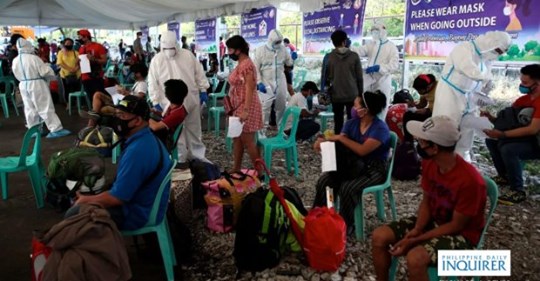
MANILA, Philippines — The World Health Organization (WHO) report that the Philippines had the fastest rise in new coronavirus cases in the Western Pacific region in the past two weeks was the result of the government’s “mishandling” of the pandemic, several senators said on Sunday.
“Something is very wrong,” Senate President Vicente Sotto III said in a Viber message to the Inquirer.
Highest among 22 countries
Asked to elaborate, Sotto cited “delays in actions and responses” of the government in tackling the virus, which first hit the country when a Chinese couple arrived on Jan. 21 from the city of Wuhan, in central China, where SARS-CoV-2, the infectious agent that causes COVID-19, emerged late last year.
“That includes contact tracing and aggressive research on medications,” he added.
Data released by the WHO late last week showed the Philippines had logged 8,143 new cases since June 16, the highest among 22 countries in the Western Pacific.
Singapore was a far second, with 2,351 cases during the same period, while China had 302.
Opposition Sen. Francis Pangilinan said the WHO report did not only prove that the Philippines had the worst record in dealing with the coronavirus crisis but also reiterated the importance of mass testing and accurate contact tracing.
“Care, not scare, for Filipinos during pandemic,” Pangilinan said, alluding to the deployment of hundreds of police commandos and military troops to Cebu City, which is battling a resurgence of the coronavirus.
“It’s embarrassing not just to our neighboring countries, but more so to fellow Filipinos, doctors, nurses and those who died to combat this disease,” Pangilinan said.
Sen. Joel Villanueva was more blunt, saying the unsettling figures were a result of the government’s decision to reopen the “economy drastically even for nonessential sectors” like Philippine offshore gaming operators, or Pogos.
Villanueva said the government should have focused on strengthening the country’s health-care system and continued providing assistance to encourage people to stay at home.
Lost focus
“I have always stated that we should be conservative in our approach in reviving the economy. For the past weeks, we lost focus on our primary goal of containing the virus,” Villanueva said.
“We did not prohibit [shopping] malls from extending their operating hours. We terminated social assistance, sent people back to work even without sufficient modes of public transportation … The current statistics are obviously consequences of these actions,” he said.
More than 100 days after President Duterte imposed strict quarantine measures, Villanueva said there was still “no clear guidance on surveillance and epidemiological monitoring.”
“We urge the government to put in place a methodologically sound epidemiological surveillance so that we can make informed decisions on our policy approach regarding [this pandemic],” he said.
Sen. Panfilo Lacson said the WHO report was expected as the Department of Health (DOH) had mishandled the government’s coronavirus response and that it even “misled” the public into believing “that everything has been under control from the start.”
Lacson assailed Mr. Duterte’s continued defense of Health Secretary Francisco Duque III, who had been blamed for the missteps in the coronavirus response as chair of the Inter-Agency Task Force for the Management of Emerging Infectious Diseases, which the senator said was “performing fairly well” despite the DOH’s “shortcomings.”
“[This is] further worsened by the President’s almost blanket trust and confidence [in] Duque, the latest of which was the ridiculous theory that he is incapable of cheating on government funds since he is too wealthy to even think of further enriching himself,” Lacson said.
Population-cases ratio
Commenting on the WHO report on Sunday, the DOH advised the public to be cautious in analyzing COVID-19 data and in comparing it between and among countries, saying several factors should be considered in data analysis.
“Let us not cherry-pick the countries we want to compare ourselves to,” the DOH said in a statement. It said the comparison with Singapore and other countries required deeper understanding of population ratio against number of cases.
“Our socioeconomic context, particularly living conditions, as well as health system capacity, even prior to COVID-19, is different from Singapore. Please take note of that when we do our analysis,” the DOH said.
It pointed out that as of Saturday, Singapore had 43,246 coronavirus cases and a population of 5.9 million compared with the Philippines’ 34,803 cases and population of 109 million.
“Per 1 million people, Singapore has [more cases, 7,393] compared with the Philippines’ 318 cases per 1 million [people],” the DOH said.
As of Sunday, the Philippines had 35,455 infections, including 653 newly reported cases. Of the new cases, 485 were fresh cases, or patients who tested positive for the new coronavirus in the past three days, and 168 were late cases, or patients who tested positive four days ago or earlier.
Of the fresh cases, 245 were from Metro Manila, 120 from Central Visayas, 112 spread across the country, and eight were repatriated overseas workers.
Of the late cases, 111 were from Metro Manila, 11 from Central Visayas, 25 from different parts of the country, and 21 were repatriates. —With a report from Tina G. Santos